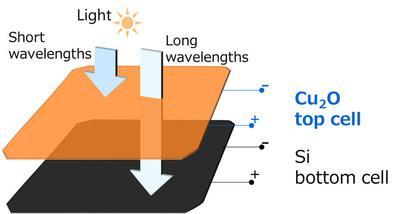Highest efficiency Cu2O solar cell

WIth 27.4 percent overall efficiency, Toshiba's Cu2O-Si tandem solar cells could carry an EV 35km without any need of recharging
Toshiba has announced that it has successfully raised the power conversion efficiency (PCE) of its transparent Cu2O solar cell to 8.4 percent, the world's highest level for a reported Cu2O solar cell. With the cell positioned as the top cell over a 25 percent PCE silicon cell (Cu2O-Si tandem cell), Toshiba estimates that an overall PCE of 27.4 percent can be achieved, notably above the 26.7 percent highest PCE reported for any standard silicon cell*2.
Under the test criteria defined by Japan's New Energy and Industry Technology Development Organization (NEDO), Toshiba estimates that the Cu2O-Si tandem cell will carry an EV 35km without any need of recharging. Looking ahead, Toshiba expects the new cell to boost development of EVs with no need for plug-in charging, and to advance other mobility applications, such as the High Altitude Platform Station (HAPS), the telecom platform in the stratosphere.
The tandem solar cell offers the promise of more efficient solar modules by combining top and bottom cells that generate power at different wavelengths. Tandem cells that achieve an overall efficiency close to 30 percent have been reported, far higher than any conventional crystalline silicon cell, but they are fabricated with III-V materials, such as GaAs, and their very high production costs─several hundred to several thousand times higher than for crystalline silicon solar cells─severely restrict application.
Toshiba has focused its R&D on transparent Cu2O cells. They are formed from naturally abundant materials, which lowers costs, and offer light transmittance that opens the way to excellent power generation efficiency. Toshiba developed the first transparent Cu2O solar cell in 2019, and demonstrated a Cu2O-Si tandem cell delivering 23.8 percent PCE in the same year, a time when the typical PCE of stand-alone silicon solar cells was 22 percent.
The company's latest advance in PCE is the result of precise control of CuO and Cu impurities during the fabrication of the cell's Cu2O layer. These impurities are generated in the current reactive sputtering deposition method*4 due to the nature of the Cu2O, and they are the major cause of diminished PCE and transparency.
Commenting on the breakthrough, Kazushige Yamamoto, Fellow at Toshiba's Corporate Research & Development Center, said: "X-ray diffraction analysis allows us to detect and quantify the degree of the CuO and Cu, giving us data that helps us to identify the best deposition method to control the impurities to the lowest level. Our targets are 10 percent PCE for the top Cu2O cell, and 80 percent of transmittance. This breakthrough brings us a step closer to those goals ."
Details on this technology were recently published in Applied Physics Letters.
With support from NEDO, Toshiba will continue research to achieve the 10 percent PCE target for top Cu2O cells. Toshiba is also cooperating with Toshiba Energy Systems & Solutions Corporation in the development of large-scale Cu2Osolar cells that are the same size as mass-produced silicon solar cells. The two companies aim to supply samples for external evaluations by FY2023, with a roadmap to completing manufacturing technologies for commercial products by FY2025.
REF
'Highly transparent Cu2O absorbing layer for thin film solar cells' by Soichiro Shibasaki et al; Appl. Phys. Lett. 119, 242102 (2021)


































